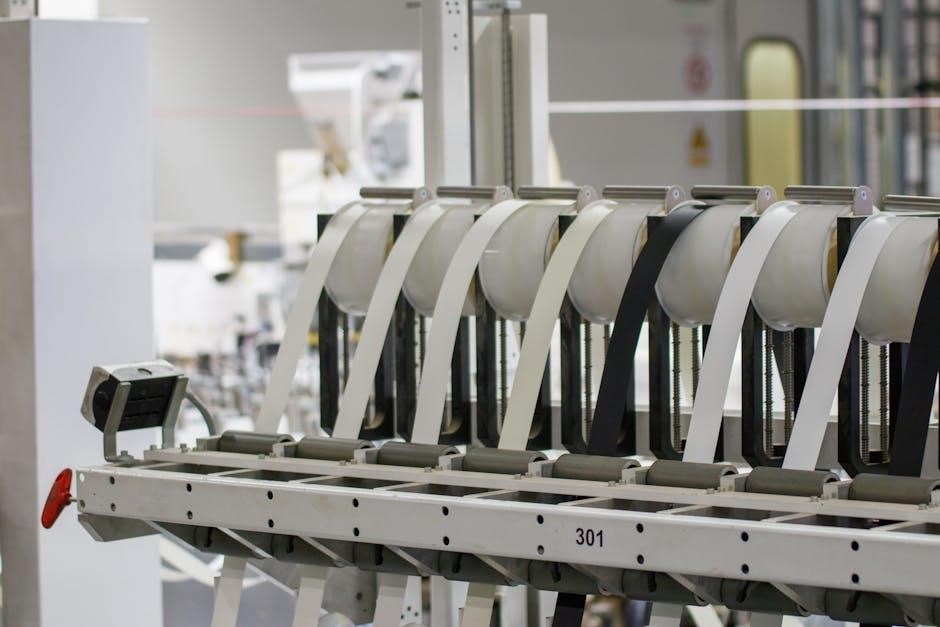Mechanical aptitude tests assess an individual’s understanding of mechanical concepts and problem-solving skills․ They are widely used in industries like manufacturing and engineering to evaluate potential candidates․ These tests often include questions on physical principles, spatial reasoning, and technical comprehension․ Resources like PDF guides and practice materials are available to help individuals prepare effectively for such assessments․
What is a Mechanical Aptitude Test?
A mechanical aptitude test is an assessment designed to evaluate an individual’s understanding of mechanical principles, spatial reasoning, and problem-solving abilities․ These tests are commonly used in industries such as manufacturing, engineering, and construction to identify candidates with strong mechanical reasoning skills․ They typically include questions on topics like gears, levers, pulleys, and basic physics․ Many resources, such as PDF guides and practice materials, are available to help individuals prepare for these assessments․ The tests aim to measure a candidate’s ability to apply mechanical concepts to real-world scenarios, ensuring they can perform tasks safely and efficiently in technical roles․ Accurate answers and logical reasoning are key to success․

Importance of Mechanical Aptitude Tests in Hiring
Mechanical aptitude tests play a crucial role in the hiring process for technical roles․ Employers use these assessments to identify candidates with strong mechanical reasoning and problem-solving skills․ By evaluating a candidate’s understanding of mechanical concepts and spatial reasoning, companies can determine their potential to perform effectively in hands-on, mechanically demanding positions․ These tests help reduce hiring risks by ensuring that selected candidates possess the necessary skills to operate machinery, understand technical instructions, and apply mechanical principles in real-world scenarios․ Moreover, they enable employers to make informed decisions, leading to better job fit and reduced training time․ As a result, mechanical aptitude tests are a valuable tool for ensuring workplace safety and productivity․
Structure of a Mechanical Aptitude Test
A mechanical aptitude test typically includes multiple-choice questions assessing mechanical principles, spatial reasoning, and technical comprehension․ The format is standardized, with clear instructions and time limits․
Types of Questions Included
Mechanical aptitude tests feature a variety of question types to assess different skills․ These include multiple-choice questions, true/false statements, and problem-solving exercises․ Many questions focus on mechanical principles, such as gears, levers, and pulleys, requiring applicants to understand basic physics and engineering concepts․ Spatial reasoning questions ask test-takers to visualize and interpret diagrams or blueprints․ Some tests also include reading comprehension sections, where candidates must interpret technical instructions or safety protocols․ Additionally, math-related problems, such as calculating forces or measuring distances, are often incorporated․ The diversity of question types ensures a comprehensive evaluation of a candidate’s mechanical knowledge and problem-solving abilities․
Time Limits and Format
Mechanical aptitude tests typically have strict time limits, ranging from 30 to 60 minutes, depending on the employer or test provider․ The format is usually standardized, with a set number of questions designed to assess mechanical knowledge and reasoning skills․ Tests may include multiple-choice questions, true/false statements, and problem-solving exercises․ Some tests feature diagrams or blueprints that require spatial interpretation․ The format is often digital, but paper-based versions are also common․ Time management is critical, as candidates must answer questions accurately within the allotted time․ Practice tests can help individuals familiarize themselves with the format and improve their ability to complete the test efficiently․ Proper preparation ensures candidates can manage their time effectively during the actual exam․

Key Topics Covered in Mechanical Aptitude Tests
Mechanical aptitude tests assess understanding of mechanical principles, spatial reasoning, and technical instructions․ They evaluate knowledge of tools, machinery, and basic engineering concepts․ Topics include motion, forces, and energy․
Mechanical Concepts and Principles
Mechanical aptitude tests heavily focus on fundamental mechanical concepts and principles, ensuring candidates understand basic mechanics․ Key topics include levers, pulleys, gears, and simple machines․ These questions assess knowledge of torque, friction, and energy transformation․ Understanding how forces interact with objects and systems is crucial․ Additionally, concepts like fluid dynamics, pressure, and basic thermodynamics are often covered․ These principles form the backbone of mechanical reasoning, allowing employers to gauge a candidate’s ability to apply theoretical knowledge to practical scenarios․ Mastery of these fundamentals is essential for success in mechanically oriented roles, making them a cornerstone of most mechanical aptitude tests․
Spatial Reasoning and Visualization
Spatial reasoning and visualization are critical components of mechanical aptitude tests, assessing the ability to mentally manipulate and interpret 2D and 3D objects․ Candidates are often presented with diagrams or schematics and asked to identify how objects fit together or how they would appear from different angles․ These questions evaluate the capacity to visualize mechanical systems, understand spatial relationships, and recognize patterns or shapes within complex designs․ Strong spatial reasoning skills are essential for roles involving equipment assembly, troubleshooting, and design․ Practice with these types of problems enhances the ability to think critically and solve mechanical problems effectively, making it a key focus for test preparation․

Reading Comprehension and Technical Instructions
Reading comprehension and technical instructions are integral to mechanical aptitude tests, evaluating the ability to interpret and apply written information․ Candidates are typically presented with technical passages, diagrams, or manuals, followed by questions that assess understanding․ These questions may involve identifying safety protocols, assembly procedures, or operational guidelines․ Strong comprehension skills are vital for roles requiring the interpretation of blueprints, repair manuals, or technical specifications․ Practice with technical texts and diagrams can improve the ability to extract and apply key information, ensuring accuracy and efficiency in problem-solving scenarios․ This section tests the ability to translate written instructions into actionable steps, a critical skill in mechanical and technical professions․

Preparing for a Mechanical Aptitude Test
Preparation involves understanding test formats, reviewing mechanical principles, and practicing spatial reasoning․ Focus on improving problem-solving skills and time management through consistent practice and study․
Tips for Effective Preparation
- Start by practicing with sample questions to familiarize yourself with the test format and timing․
- Focus on understanding basic mechanical principles, such as levers, gears, and pulleys․
- Improve spatial reasoning by solving puzzles and visualizing 3D objects․
- Review technical reading comprehension to interpret instructions and diagrams accurately․
- Allocate dedicated study time each day to build consistency and confidence․
- Identify and address weak areas through targeted practice and review․
- Use visualization techniques to mentally solve problems before attempting them․
- Stay calm during the test by managing time effectively and avoiding rushed decisions․
Regular practice and a structured approach will significantly enhance your performance․
Recommended Study Resources
To excel in a mechanical aptitude test, utilizing the right study materials is crucial․ Downloadable PDF guides, such as Mechanical Aptitude Test Study Guide or Ultimate Mechanical Aptitude Test Prep, are excellent resources․ These guides often include practice questions, detailed explanations, and tips for improving problem-solving skills․ Additionally, websites like Test-Guide․com and JobTestPrep offer comprehensive PDF resources tailored to specific tests․ Free PDF guides can also be found on platforms like Scribd or Google Drive, covering topics like mechanical principles and spatial reasoning․ Supplements like Mechanical Aptitude Test for Dummies provide clear, accessible explanations․ Combining these resources with consistent practice ensures a well-rounded preparation strategy․ Online forums and communities often share trusted PDF materials, making them a valuable resource for test-takers․ Always prioritize materials that align with the test’s format and content for optimal results․
Practice Tests and Sample Questions
Practice tests and sample questions are essential for assessing readiness․ Many mechanical aptitude test PDFs include timed exercises and answers, mimicking real exam conditions․ Use these tools to refine problem-solving skills and reduce test anxiety․ Websites like Test-Guide․com offer free and paid resources․ Regular practice helps identify weaknesses and improves accuracy․ Always review explanations to understand mistakes and learn from them․
Where to Find Reliable Practice Materials

Reliable mechanical aptitude test PDFs can be found on official test publisher websites, such as the Bennett Mechanical Comprehension Test or Wiesen Test of Mechanical Aptitude․ Online platforms like Test-Guide․com offer free and paid practice materials․ Additionally, books like Mechanical Aptitude Tests by McGraw-Hill provide comprehensive practice questions․ Websites like Amazon and eBay also host a variety of test prep resources․ To ensure quality, look for materials from reputable sources and read reviews․ Many free PDF guides are available by searching keywords like “free mechanical aptitude test PDF” or “download mechanical aptitude practice test․” Always verify the source to avoid outdated or inaccurate content․
How to Analyze Sample Questions
Start by carefully reviewing each sample question in your mechanical aptitude test PDF․ Identify the type of question, such as mechanical concepts, spatial reasoning, or technical instructions․ Pay attention to the format, like multiple-choice or visual problems․ Analyze the answer choices to understand common patterns and distractors․ For visual questions, practice breaking down diagrams and identifying key components․ Review the correct answers and explanations to grasp the logic behind them․ Eliminate incorrect options by process of elimination․ Note recurring themes or topics to focus your study efforts․ Finally, test yourself under timed conditions to simulate real-test pressure․ This method ensures you gain insights into the test structure and improve your problem-solving skills effectively․

Understanding Your Test Results
Your mechanical aptitude test results reveal your strengths and areas needing improvement․ Scores are often ranked to indicate proficiency levels, providing clear feedback for targeted growth․
Interpreting Scores and Feedback
Interpreting your mechanical aptitude test scores involves understanding percentile rankings and category-specific performance․ Feedback highlights strengths, such as mechanical reasoning or spatial visualization, and identifies weaker areas needing improvement․ Many tests provide detailed reports, breaking down scores by topic, allowing you to pinpoint where to focus your studies․ For example, if you scored low on gear systems, prioritize reviewing related concepts․ Use this feedback to create a targeted study plan, ensuring you address gaps in knowledge․ Additionally, some tests offer explanations for incorrect answers, helping you learn from mistakes․ By analyzing your results thoroughly, you can develop a strategic approach to enhancement and better prepare for future assessments․

Improving Based on Results
Improving based on your mechanical aptitude test results requires a structured approach․ Start by identifying areas where you underperformed, such as mechanical principles or spatial reasoning․ Focus your study efforts on these weaknesses using targeted resources like mechanical aptitude test PDF guides or online tutorials․ Regular practice with sample questions can help reinforce concepts and build confidence․ Additionally, review explanations for incorrect answers to understand common pitfalls․ Setting realistic goals and tracking progress over time can ensure steady improvement․ Finally, simulate test conditions during practice to enhance time management and reduce test-day anxiety․ Consistent effort and a focused strategy will help you achieve better results in future assessments․
Resources for Further Learning
Explore free mechanical aptitude test PDF guides, online courses, and tutorial websites offering in-depth mechanical concepts and practice exercises to enhance your skills effectively․
Free PDF Guides and Study Materials
Free PDF guides and study materials are excellent resources for preparing for mechanical aptitude tests; These documents often include practice questions, detailed explanations, and tips for improving problem-solving skills․ Many websites offer downloadable PDFs specifically designed for mechanical aptitude tests, covering topics like mechanical principles, spatial reasoning, and technical comprehension․ Additionally, some PDF guides provide sample questions and answers, allowing you to assess your knowledge and identify areas for improvement․ Platforms like official test provider websites, educational forums, and career development sites often host these resources․ Utilizing these materials can help you study efficiently and gain confidence in tackling complex mechanical problems․ Regular practice with these guides ensures a strong foundation for test success․
Online Courses and Tutorials
Online courses and tutorials are valuable tools for preparing for mechanical aptitude tests․ These resources provide structured learning experiences, often including video lessons, interactive exercises, and quizzes․ Many platforms offer courses specifically designed to improve mechanical reasoning, spatial visualization, and technical comprehension․ Websites like Udemy, Coursera, and specialized test prep sites host these courses, catering to different skill levels․ Additionally, some tutorials focus on real-world applications of mechanical principles, helping you understand practical scenarios․ Engaging with these courses allows you to learn at your own pace and reinforce concepts through hands-on practice․ They are especially useful for those who prefer guided instruction and want to build a strong foundation for test success․ Regular participation in these programs can significantly enhance your problem-solving abilities․

Mechanical aptitude tests are crucial for assessing technical skills․ Proper preparation and practice ensure success․ Continuous learning and mastering mechanical concepts will benefit future endeavors․

Final Tips for Success
To excel in mechanical aptitude tests, focus on mastering basic principles like levers, gears, and pulleys․ Practice spatial reasoning by visualizing shapes and objects․ Time management is key—prioritize questions you’re confident about first․ Use reliable practice materials, such as mechanical aptitude test PDFs, to familiarize yourself with test formats․ Stay calm during the test and avoid guessing unless necessary․ Reviewing your results and identifying weaknesses can guide further study․ Continuous learning and hands-on experience will enhance your problem-solving skills․ By combining preparation and confidence, you’ll improve your chances of success in both the test and your career․
Importance of Continuous Learning
Continuous learning is vital for long-term success in mechanical aptitude tests and related fields․ As technology advances, staying updated with new tools and concepts ensures adaptability․ Regular practice with mechanical aptitude test PDFs reinforces foundational knowledge and builds problem-solving skills․ Engaging in ongoing education helps professionals stay competitive and confident․ Additionally, continuous learning fosters a mindset of growth, enabling individuals to tackle complex challenges effectively․ Investing time in learning resources and practical exercises ensures sustained improvement and readiness for future opportunities․
